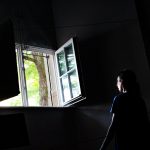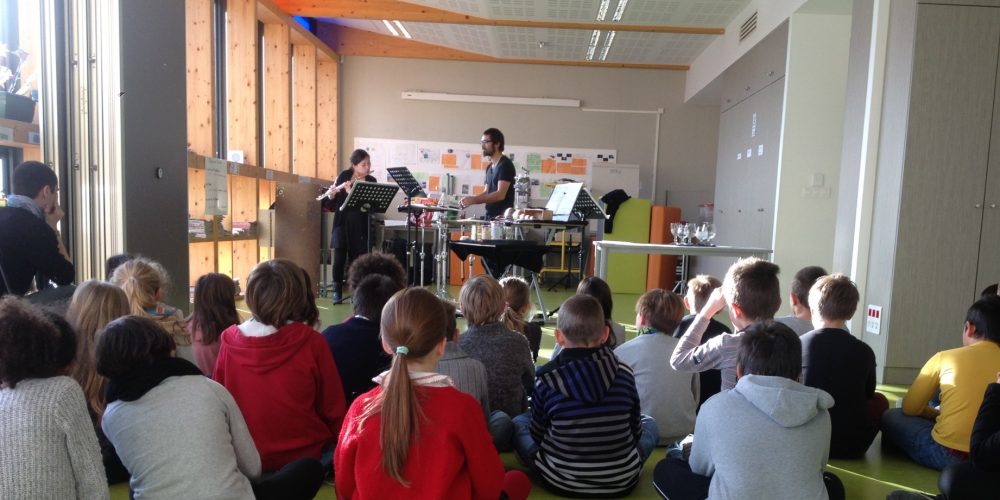Summary
Put the child in an extraordinary situation, to get him out of his daily life in order to discover non-ordinary sounds and to offer him a receptive (active) and non-consuming (passive) listening situation.
The program must be constructed and coherent: presenting a group of representative pieces from different eras, aesthetics and modes of play, that have been developed for the instrument.
Duration: 45 min
Age: from age 8
Key words creativity and entrepreneurship: working in teams, flow of ideas, enthusiasm, imagination, interaction with the environment
Description
Step 1 First meeting
- First listening
The musician plays the piece without announcing either the title or the name of the composer.
Teacher-guided exchange after first listening
Contents: to raise questions about the title, the era, similarities with repertoire or known sound situations.
The musicians can complete the remarks by explaining their understanding of the works played.
Have students ask questions about the pieces.
Musicians can also ask questions of the children to help them think about the types of instruments used, the modes of play and the musical intentions. They will listen to children, eyes closed, to some representative passages of the sonic palette of the instrument using a maximum number of modes of play.
Competencies:
The pupils are able to:
- comment and ask questions about the pieces they have just listened to;
- develop their critical spirit and their taste;
- refine their listening.
- Second listening
Content: To complete the session students will be offered a second listening opportunity in order to re-hear the repertoire, taking into account the discoveries made during the first listening. It is not necessary to replay all the pieces, it is better to isolate some representative passages and to keep just one of the whole pieces.
Competencies:
The pupils are able to:
- recognize instruments;
- discern aesthetics;
- differentiate modes of play;
- have listened to real music in an extra-ordinary situation.
- Imitative Play
Listen to the musician and then imitate his voice, alone or with others
- Presentation of a musical moment to the pupils by the musicians
If the students have prepared a musical piece, they should present it to the musicians
- Playing together
If the students have prepared a musical moment of an appropriate aesthetic for the meeting and if the musicians are agreeable, suggest that the students and musicians play together. It will be necessary to define in which way.
Step 2 Encountering contemporary music without musicians present in class
Content: identical to that in step 1, however the teacher may prepare the sequence using a document or documentary to guide the listening of the performance by the ensemble if necessary.
DVD Teaser: 5 pieces by Samuel Andreyev
Ayako Okubo flute and Olivier Maurel percussions
Get to know the instruments and different modes of play
From the twentieth century, composers and instrumentalists explore instruments to exploit all sound phenomena that create new modes of play and new notations.
Side blown flutes
Locating modes of play in the video:
Side blown flute
0”00 Breathing sound
0”21 Key noises
0”44 Cluster
0”58 Tongue-ram
1″07 His breathing + Tongue-ram
Bass flute
0”00 “Normal” sound
0”20 Breathing sound
0”35 Flutterzung
0”48 Slap / Pizzicato
1”00 Tongue-ram
1”08 Inside flutterzung
1’18 Multi phonic
Piccolo
0”01 “Normal” sound
0”16 Flutterzung
0”25 Tongue-ram
Percussions
Locating percussion playing modes in the video:
0 “02 Tin can with the olive of a knitting needle, resonant
0” 04 Tin can with the olive of a knitting needle, muffled
0 “06 tin can with shaft of a knitting needle, muffled
0 “08 tin can with shaft of a knitting needle, resonant
0 “12 ridged side of the tin can rubbed with shaft of a knitting needle, resonant
0 “16 Temple block struck with a chopstick
0 “20 Temple block struck with a rubber strip (here a xylophone stick)
0 “24 Temple block struck with a wooden stick (here a mokucho stick, Taoist prayer instrument)
0 “29 Five levels of temple blocks (1-2-4-3-5 and 1-2-3-4-5) played with the handle of a chopstick, then with the head
0 “44 Grinding the Tam by rubbing hard with the end of a chopstick
1 “04 Two ways to rub a medium sized tam with a metal brush.
1 “22 The same tam played with a superball (bouncing ball)
1 “45 The same tam played with olive of a knitting needle, gradually muffled, then the same with the body of the needle
2 “08 tom rubbed with a stiff wire brush (this brush is called” dreadlocks “)
2 “16 The Tam played with a soft stick.
2 “33 A motif composed of the play of ‘hard rubbing” with a chopstick with muffled impact
2 “44 A motif composed of the play of a chopstick on metal saucers coffee cup, temple block and tin.
2 “48 Saucers played with a bow
3 “06 A ride’ cymbal played with drumstick sleeves. First on the top, then on the edge, finally on the dome.
3 “27 The same cymbal played with the head of a marimba stick.
3 “36 A rolling cymbal with soft sticks
4 “08 The same rolling cymbal short and muffled
4 “13 The same cymbal struck with the same stick, on the edge but” filtered “with the left hand
4 “20 a strike near the dome and on the edge with the handle
4 “27 The edge of the cymbal, struck filtered again
Step 3 Learn to hear: record, listen, comment, open your ears to the sounds in your environment
Record: nature, the environment, what we hear when we open the classroom window.
- Listen: recording or the environment in silence.
- Comment: the teacher can guide the comments with questions
Tools to guide listening:
Establish a vocabulary with the students to describe a sound, talk about listening by asking: speed, intensity, hue, dynamic, movement, character, height variation, density, stroke, texture, mode of play, brightness, tone, taste, space, fantasy, phrasing, arrangement, etc.
- Replay and comment again
- Imitative Play
- Open the classroom window: listen, comment, imitate alone or with others
- Record the environment, the sounds of nature: listen to the recording, imitate alone or together
NB: imitation can be made with the voice or with any other instrument or sound body.
Competencies
The pupils are able to:
- listen actively in concert situations;
- develop the critical spirit and the taste;
- refine the listening;
- recognize instruments;
- discern aesthetics;
- differentiate modes of play;
- have listened to real music in an extra-ordinary situation.
Materials
According to the proposals: no equipment needed or CD player or DVD player or internet access
Module Overview
|
